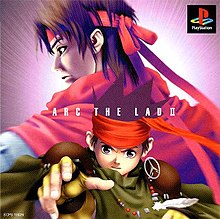Wizardry is a series of role-playing video games, developed by Sir-Tech, that were highly influential in the evolution of modern role-playing video games. The original Wizardry was a significant influence on early console role-playing games such as Final Fantasy and Dragon Quest. Originally made for the Apple II, the games were later ported to other platforms. The last game in the original series by Sir-Tech was Wizardry 8, released in 2001. There have since been various spin-off titles developed for the Japanese market.
Dragon Quest, previously published as Dragon Warrior in North America until 2005, is a series of role-playing games created by Japanese game designers Armor Project, Bird Studio and Sugiyama Kobo to its publisher Enix, with all of the involved parties co-owning the copyright of the series since then. The games are published by Square Enix since its inception, with localized remakes and ports of later installments for the Nintendo DS, Nintendo 3DS, and Nintendo Switch being published by Nintendo outside of Japan. With its first game published in 1986, there are eleven main-series games, along with numerous spin-off games. In addition, there have been numerous manga, anime and novels published under the franchise, with nearly every game in the main series having a related adaptation.

A role-playing video game, commonly referred to as a role-playing game (RPG) or computer role-playing game (CRPG), is a video game genre where the player controls the actions of a character immersed in some well-defined world, usually involving some form of character development by way of recording statistics. Many role-playing video games have origins in tabletop role-playing games and use much of the same terminology, settings, and game mechanics. Other major similarities with pen-and-paper games include developed story-telling and narrative elements, player character development, complexity, as well as replay value and immersion. The electronic medium removes the necessity for a gamemaster and increases combat resolution speed. RPGs have evolved from simple text-based console-window games into visually rich 3D experiences.

The Slime series is a spinoff series of games from Dragon Quest featuring its Slime character. Three games have been released, the second of which, Dragon Quest Heroes: Rocket Slime, has been released in North America.

Dragon Quest II: Luminaries of the Legendary Line, titled Dragon Warrior II when initially localized to North America, is a role-playing video game developed by Chunsoft and published by Enix in 1987 for the Nintendo Entertainment System as a part of the Dragon Quest series. Enix's U.S. subsidiary published the American release, Dragon Warrior II, for the Nintendo Entertainment System in 1990. Dragon Quest II is set one hundred years after the events of the first game.
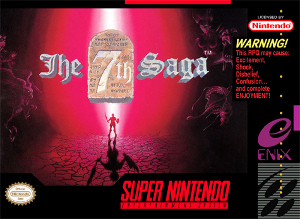
The 7th Saga is a turn-based role-playing video game developed by Produce! and published by Enix for the Super Nintendo Entertainment System in 1993. The game made innovative use of a radar system during gameplay. It featured 7 playable characters of various types including humans, an elf, a dwarf, robots, a demon, and an alien. Each character has unique items and spells.

Shadow Hearts: Covenant is a role-playing video game developed by Nautilus (Sacnoth) for the PlayStation 2, and is the second entry in the Shadow Hearts series. Published in Japan by Aruze in 2004, the game was released internationally by Midway Games in 2004 and 2005 (Europe). A director's cut with additional content was released in Japan in 2005.
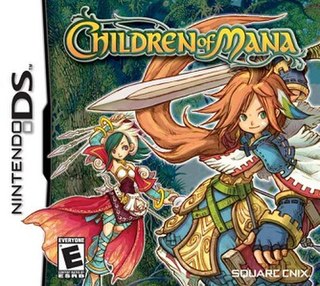
Children of Mana is a 2006 action role-playing game for the Nintendo DS handheld console. It was developed by Square Enix and Nex Entertainment, and published by Square Enix and Nintendo. It is the sixth game of the Mana series—following 2003's Sword of Mana—and the first entry in the World of Mana subseries. Set in a high fantasy universe, Children of Mana follows one of four young heroes as they combat an invasion of monsters and learn about the cataclysmic event that killed their families.
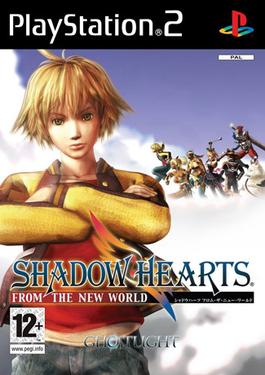
Shadow Hearts: From the New World is a role-playing video game developed by Nautilus (Sacnoth) for the PlayStation 2. It was published in Japan by Aruze in 2005, in North America by Xseed Games in 2006, and in Europe by Ghostlight in 2007. From The New World is the third and final game in the Shadow Hearts series, acting as both a continuation of the series narrative and a spin-off featuring new characters.
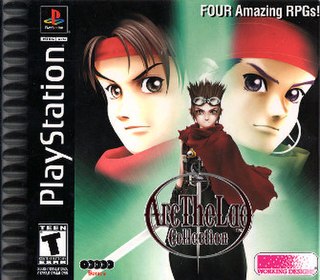
Arc the Lad Collection is a compilation of the Arc the Lad RPGs for the PlayStation. The games were localized by Working Designs. Plans to localize the games had been fostered by Working Designs since the late 1990s, but the compilation was not released until 2002.
Mystery Dungeon, known in Japan as Fushigi no Dungeon, is a series of roguelike role-playing video games. Most were developed by Chunsoft, now Spike Chunsoft since the merging in 2012, and select games were developed by other companies with Chunsoft's permission. The series began when co–creator of Dragon Quest, Koichi Nakamura, was inspired by Seiichiro Nagahata's experience with Rogue, who is also a fellow developer from the company, and a desire to create an original series. It began on the Super Famicom, progressing to almost all of Nintendo's and Sony's home and handheld consoles, WonderSwan, Dreamcast, Windows, and mobile devices.
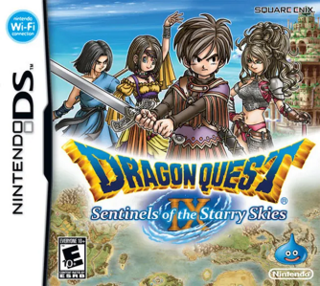
Dragon Quest IX: Sentinels of the Starry Skies is a role-playing video game co-developed by Level-5 and Square Enix for the Nintendo DS. Published by Square Enix in Japan in 2009, and by Nintendo overseas in 2010, it is the ninth mainline entry in the Dragon Quest series. The storyline follows the protagonist, a member of the angelic Celestrian race, after a disaster in their home scatters magical fruits across the mortal realm. While carrying over traditional gameplay from the rest of the series with turn-based battles, the game is the first Dragon Quest entry to feature a customizable player character, and the first to include a multiplayer mode, with the option of trading treasure maps and loaning player characters through Nintendo Wi-Fi. Online functions ended in 2014 when it ceased operations.

Arc the Lad is a tactical role-playing video game developed by G-Craft and published by Sony Computer Entertainment exclusively for the PlayStation. It was the best-selling Japanese PlayStation game of 1995 with over a million copies sold.

Dragon Quest Monsters, released in North America as Dragon Warrior Monsters, is the first video game in the Dragon Quest Monsters series. It was released in Japan by Enix on September 25, 1998, and co-published by Eidos Interactive in Europe and North America in 2000. It was the first Dragon Quest game to be released in Europe. The game cartridge is compatible with both the black-and-white Game Boy and the Game Boy Color; a second printing of the game was made after the Game Boy Color itself was released. The game was remade for the PlayStation in a compilation Dragon Quest Monsters 1+2 Hoshi Furi no Yūsha to Bokujō no Nakamatachi. A mobile phone incarnation titled Dragon Quest Monsters i was released in Japan on January 28, 2002.

Fatal Frame III: The Tormented is a survival horror video game developed by Tecmo for the PlayStation 2. The third entry in the Fatal Frame series, it was published by Tecmo in 2005 in Japan and North America, and by Take-Two Interactive in Europe in 2006. Set after the events of the first two games, the story revolves around three characters who lost loved ones and are drawn into the supernatural Manor of Sleep. The gameplay revolves around exploring the Manor and tackling hostile ghosts using the Camera Obscura. Each character has different strengths and weaknesses, such as stronger attack or stealth elements.

Arc the Lad is a series of tactical role-playing games created by Toshiro Tsuchida and published by Sony Interactive Entertainment. Each Arc the Lad game often features recurring characters and locations, as well as a consistent timeline. Most of the stories in the series involves a cast of characters battling against the forces of an evil organization or empire, with monsters attacking the world alongside them. The series features a similar strategy-like battle system, which all games except Arc the Lad: End of Darkness follow.

Etrian Odyssey III: The Drowned City is a 2010 3D dungeon crawler role-playing video game by Atlus for the Nintendo DS. It is a sequel to Etrian Odyssey II: Heroes of Lagaard. Players assume the role of a guild leader, adventuring into the labyrinth to fulfill quests.
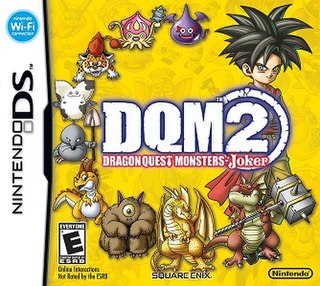
Dragon Quest Monsters: Joker 2 is a 2010 role-playing video game developed by Tose and published by Nintendo for the Nintendo DS. It is the sequel to Dragon Quest Monsters: Joker (2006) and is the fifth game in the Dragon Quest Monsters series. A sequel, Dragon Quest Monsters: Joker 3, was released in 2016.
Dragon Quest is a series of role-playing video games that originated in 1986 with the release of the first game in the series. Although the games are not related in terms of story, many aspects of the gameplay are consistent throughout the series. Each game in the series add new elements to the gameplay, such as longer quests, character classes, or different ways of story-telling.
While the early history and distinctive traits of role-playing video games (RPGs) in East Asia have come from Japan, many video games have also arisen in China, developed in South Korea, and Taiwan.
